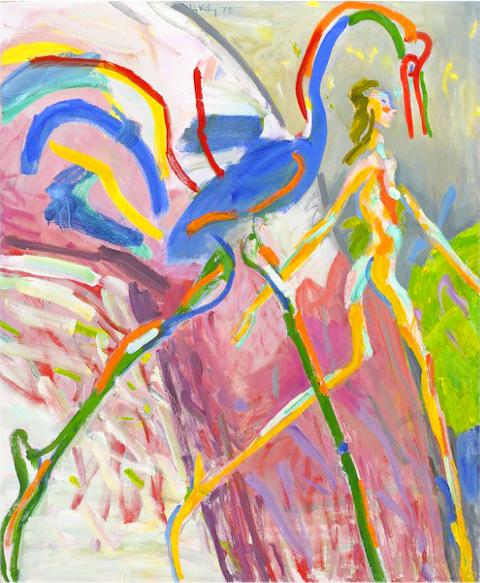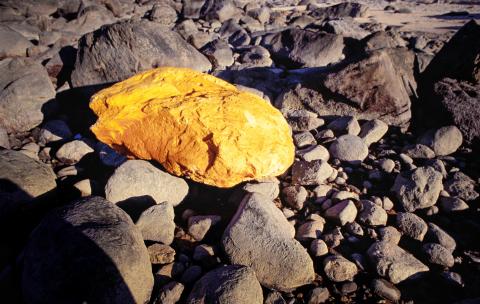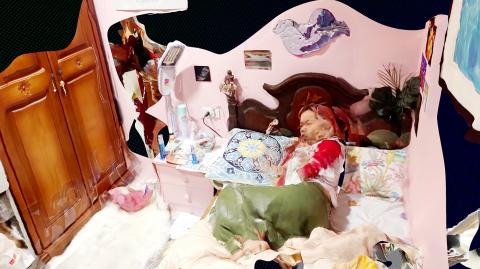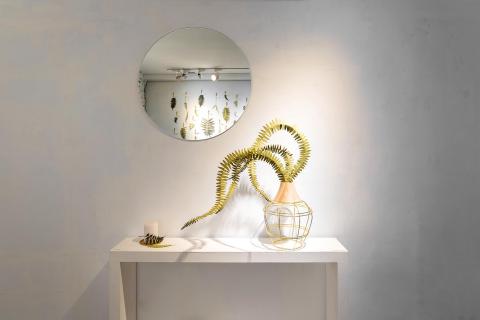Video on the Phone is an exhibition viewed on smartphones with internet access. Bring your own smartphone and virtual reality (VR) headset; those without a VR headset, Google Cardboards are available for rent at the Hong Gah Museum and Polymer Art Village. The show features the work of 17 artists working in VR videos, YouTube Web casts, live-streaming, talks and other Web forms of creation. According to the organizers, “their interests on topics range from virtual space and characters in the X generation to the self-media generation after the millennium.” Despite the online nature of the show, viewers access the exhibition by physically walking along a route between the Hong Gah Museum and Polymer Art Village, scanning various QR codes scattered along the way. Chen I-chun’s (陳依純) Goodbye Little Factory is a three-channel video about labor and its relevant symbols and signs in the context of globalization. “In a new world characterized by flexible systems of signification, everything traditional or solid will eventually become a thing of the past,” reads the exhibition brochure. Hu Ching-chuan’s (胡鈞荃) looped VR video, Uncanny Field (異域), is based on the living spaces of her relatives and friends who live throughout the globe. Using 3D scanning software and lens capturing methods, Hu developed imagery that was then processed and altered in 3D software to create a space that appears “more real than reality.”
■ The exhibition takes place in two venues: Hong Gah Museum (鳳甲美術館), 11F, 166 Daye Rd, Taipei City (台北市大業路166號11樓), tel: (02) 2894-2272.; Polymer Art Space (空場藝術聚落), 3F, 9, Beitou Rd, Taipei City (台北市北投路一段9號3樓), tel: (02) 2898-2647. Open Tuesdays to Sundays from 10:30am to 5:30pm
■ Until Sept. 23

Photo Courtesy of Galerie Grand Siecle
Wu Shang-yung (吳尚邕) is an artist and director of Association of the Visual Arts in Taiwan. His artistic practice encompasses many mediums, including painting, video and installation. Wu is interested in exploring daily phenomena and the essence of things through creative use of social deconstruction, analysis and observation. In this process, he searches for “the unstable nature of events [that are] connected to its time and space.” Wu’s solo exhibition, Tilted Seas (傾斜的海平面), presents a new series of works that deal with the process of interpreting reality. “When facing unfamiliar events, we tend to look around for signals that we feel connected to,” writes the gallery in a press release. In the process of seeking understanding, one may draw from objective knowledge and subjective experiences, which lead to different ways of seeing for different people, the gallery adds. The images, objects and installations presented in this show create a network of relationships that can trigger for the viewer interesting creative interpretations.
■ VT Art Salon (非常廟藝文空間), B1, 17, Ln 56, Sec 3, Xinsheng N Rd, Taipei City (台北市新生北路三段56巷17號B1), tel: (02) 2597-2525. Open Tuesdays to Fridays from 11:30am to 7pm, and Saturdays from 1:30pm to 9pm
■ Until Sept. 22

Photo Courtesy of National Palace Museum
Galerie Grand Siecle presents Animals, Figures and His Realm (動物、肖像與他的王國), a retrospective of late American artist, theorist and professor Irving Kriesberg. Kriesberg was based in New York while also sojourning in Mexico, India and Japan for several years. “The sustained influence of different cultures and arts cultivate a deep impact on his [visual] language,” writes the gallery. The show seeks to do the impossible and summarize Kriesberg’s 60-year career with a selection of 12 works created between 1974 and 2003. His expressionistic-like paintings often depict “haunting images of human and animal forms,” including frogs, birds, angels and other motifs. Walking Out (1978) depicts a nude woman and towering crane walking past a layered background of both distant space and flatness, existing in ambiguous space between representation, caricature and abstract brush strokes. Close Quarters is a more subdued picture confined by a clean yellow frame, in which a figurative form has morphed into a winding tube-like architectural structure. Kriesberg’s work is known for its vibrant color and witty symbolism. “[D]ancers weave through space at unorthodox angles, and customarily static objects appear fluid and sinuous… all these things gave his work a sense of wit and mystery,” writes the gallery.
■ Galerie Grand Siecle (新苑藝術), 17, Aly 51, Ln 12, Bade Rd Sec 3, Taipei City (八德路三段12巷51弄17號), tel: (02) 2578-5630. Open Tuesdays to Sundays from 1pm to 6pm
■ Until Sept 7

Photo Courtesy of VT Art Salon
Whereto Paradise: Picturing Mountains of Immortality in Chinese Art (何處是蓬萊:仙山圖特展) is a exhibition about the legendary paradise mountains celebrated in Chinese mythology. Mount Penglai (蓬萊), Kunlun (崑崙), Yingzhou (瀛洲) and Fangzhang (方丈) are four spiritual mountains described in historical records and literature as spiritual realms of immense beauty. These mountains are sites of immortality, inhabited by sages, mythical beasts and medicinal plants. According to the National Palace Museum, the legends became increasingly popular with the rise of Taoism from the Six Dynasties period to the Tang Dynasty and spurred many speculations that the mountains were physical places on existing maps. The show features paintings from the Song, Yuan, Ming and Qing dynasties that deal with the land of immortals. Hall in Mountains of the Immortals (緙絲仙山樓閣) is a silk tapestry from the Song Dynasty that depicts an ornamented, two-storied hall tuck behind an almost symmetrical landscape of rocks, birds, monkeys and flowers. A party of people chatters about in the corridors of the hall, while white cranes and phoenixes fly amid highly stylized clouds in the sky. Fanghu (方壺圖) is a Ming Dynasty scroll of ink on paper that illustrates the island mountain Fanghu (also known as Fangzhang) surrounded by an expanse of waves. According to legend, the mountains “appear similar to clouds from a distance; but as people approach they dip below the water and in the end are blown away by the wind.”
■ National Palace Museum (國立故宮博物院), 221 Zhishan Rd Sec 2, Taipei City (台北市至善路二段221號), tel: (02) 2881-2021. Open daily from 8:30am to 6:30pm; closes at 9pm on Fridays and Saturdays
■ Until Sept. 25

Photo Courtesy of Hong-Gah Museum
Wuba Yang (五八) is a paper-cutting artist with a background in industrial design. She has been passionate about paper-cutting since childhood and utilizes a combination of modern and traditional techniques to create a rich, personal style. Yang’s themes include animals and plants; she is passionate about mending art with life and “sharing the goodness of paper-cutting.” In her current show, Paper Plants (紙植物), the artist presents a display of paper ferns; some are assembled as compositions on the wall, while others are placed in glass vases. The show includes 12 types of ferns commonly found in Taiwan. Yang was first inspired to create paper ferns through her personal experiences in furnishing interiors with greenery. She says that her inability to care for her own plants spurred her interest in plants. Through her paper-cutting practice, Yang creates sculptural forms of fauna and flora that communicate the different gestures and beauty of nature.
■ A Day (日常生活), 11, Ln 46, Aly 553, Zhongxiao E Rd Sec 4, Taipei City (台北市忠孝東路四段553巷46弄11號), tel: (02) 2766-7776. Opens Daily from 12pm to 9pm.
■ Until Aug. 26

Photo Courtesy of the artist

Taiwan Power Co (Taipower, 台電) and the New Taipei City Government in May last year agreed to allow the activation of a spent fuel storage facility for the Jinshan Nuclear Power Plant in Shihmen District (石門). The deal ended eleven years of legal wrangling. According to the Taipower announcement, the city government engaged in repeated delays, failing to approve water and soil conservation plans. Taipower said at the time that plans for another dry storage facility for the Guosheng Nuclear Power Plant in New Taipei City’s Wanli District (萬里) remained stuck in legal limbo. Later that year an agreement was reached

What does the Taiwan People’s Party (TPP) in the Huang Kuo-chang (黃國昌) era stand for? What sets it apart from their allies, the Chinese Nationalist Party (KMT)? With some shifts in tone and emphasis, the KMT’s stances have not changed significantly since the late 2000s and the era of former president Ma Ying-jeou (馬英九). The Democratic Progressive Party’s (DPP) current platform formed in the mid-2010s under the guidance of Tsai Ing-wen (蔡英文), and current President William Lai (賴清德) campaigned on continuity. Though their ideological stances may be a bit stale, they have the advantage of being broadly understood by the voters.

In a high-rise office building in Taipei’s government district, the primary agency for maintaining links to Thailand’s 108 Yunnan villages — which are home to a population of around 200,000 descendants of the Chinese Nationalist Party (KMT) armies stranded in Thailand following the Chinese Civil War — is the Overseas Community Affairs Council (OCAC). Established in China in 1926, the OCAC was born of a mandate to support Chinese education, culture and economic development in far flung Chinese diaspora communities, which, especially in southeast Asia, had underwritten the military insurgencies against the Qing Dynasty that led to the founding of

Artifacts found at archeological sites in France and Spain along the Bay of Biscay shoreline show that humans have been crafting tools from whale bones since more than 20,000 years ago, illustrating anew the resourcefulness of prehistoric people. The tools, primarily hunting implements such as projectile points, were fashioned from the bones of at least five species of large whales, the researchers said. Bones from sperm whales were the most abundant, followed by fin whales, gray whales, right or bowhead whales — two species indistinguishable with the analytical method used in the study — and blue whales. With seafaring capabilities by humans